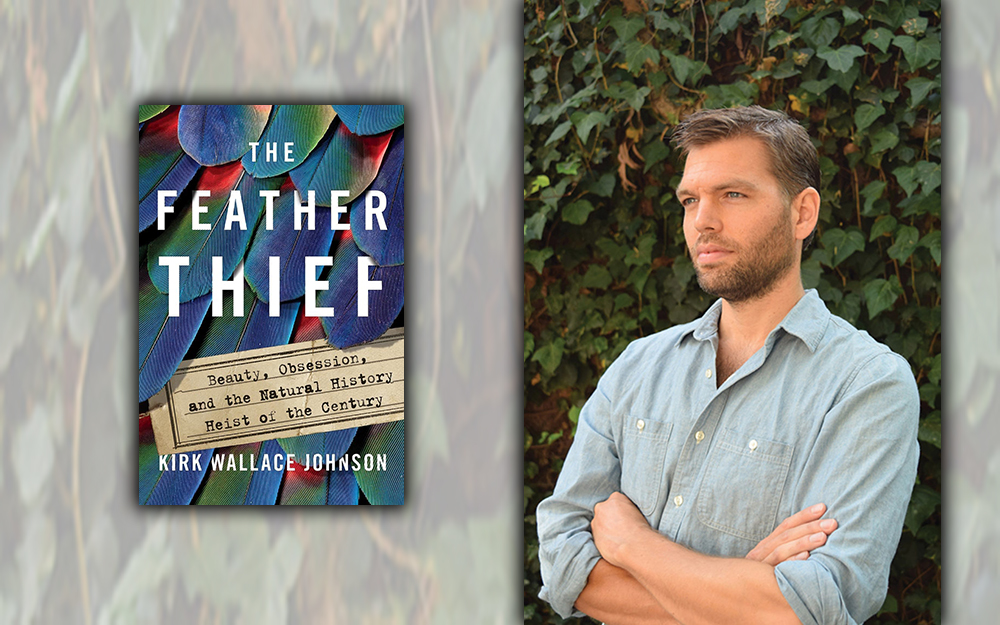
Book Review by Heidi Simmons
—–
The Feather Thief
by Kirk Wallace Johnson – Nonfiction
—–
If the human race doesn’t wipe out exotic animal species by polluting our planet, it may do so by destroying creatures for their sublime beauty or imagined powers. In Kirk Wallace Johnson’s The Feather Thief: Beauty, Obsession, and the Natural History Heist of the Century (Viking, 308 pages), a man’s unlikely compulsion is examined.
The story begins with the author taking a much-needed break for fly-fishing. While knee deep in a river, his guide shares information about a British natural history museum that was robbed of rare and extinct birds for the purpose of fly-tying.
Fly-tying is combining fur, feathers and thread neatly around a fishhook to mimic colorful flies in order to lure and catch the best stream fish. It is a far more popular art form than a utilitarian craft. There are global websites and conventions for fly-tiers who have never stepped into a body of water or seen the fish the hooks are meant to catch.
Enter Edwin Rist who was a child prodigy. Homeschooled and precocious, he loved to play the flute. He also discovered fly-tying was a good way to express his artistic side. At 11-years-old, the world fly-tying community named him “Best Fly-tier of the Year.”
Finishing community college at 16, Rist applied to London’s Royal Academy of Music with big plans to be first flautist for the Berlin Symphony Orchestra. He resumed fly-tying between practicing music and classes. When he heard there was a significant collection of rare “bird skins” that were highly valued in the fly-tying market, Rist had to see them for himself. They could be worth a fortune.
Skins are cotton stuffed and tied birds scientifically persevered for research. Under false pretenses, Rist got into the museum where the exotic birds where stored. Months later, he broke in and stole 299 skins. It took the museum’s curators a year to discover what was taken, and another year to catch Rist.
With only six months to graduation and on-going orchestra auditions, Rist was caught by a British detective. Rist confessed. He was 20 years old.
Author Johnson begins the book with British natural history and the quest to find exotic creatures.
The birds Rist stole were tagged 150 years earlier by Alfred Russel Wallace, a contemporary of Darwin’s. Wallace’s journey to collect the birds and other species was harrowing. His first collection was destroyed when the ship home caught fire. He and the crew were adrift after the boat sank. Most of his notes and drawings were lost. Wallace then spent another four years searching, retrieving and documenting birds, bugs and rare creatures, which finally made it back to England.
Johnson tells the story of how exotic birds became valuable through fashion and how the skins ended up in the UK’s Tring Natural History Museum during the WWII. It is a fascinating history.
Rist, however, did not serve time for his crimes. His attorney got him off with an “Asperger’s defense.” Rist graduated and got a job as a professional musician in Berlin.
The book really takes off in the final third when author Johnson himself decides he wants to recover the missing skins for the Tring museum that were sold to fly-tiers before Rist was caught. Of the 299 skins, 106 bird skins were returned by Rist, while 96 remained out in the world.
As Johnson tracks down the fly-tier players, he begins to believe that Rist could not have operated by himself. But as Johnson starts knocking on doors, the fly-tying community shuts him out. Hundreds of thousands of dollars may have been exchanged as fly-tiers scooped up the rare birds and feathers.
Besides the crime, The Feather Thief takes a look at what it means to preserve our natural history. The museum curators see the birds as important for questions that have yet to be asked. Long after we are gone, the birds will tell a story of the planet during their time on earth. The fly-tiers believe they have the right to use these creatures for their art or hobby, and having one or two birds preserved should be adequate for science.
There are many relevant and timely themes in the book. For instance, how willing humans are to exploit earth’s creatures for capital gain and vanity. I liked that Johnson included the campaign against women’s fashions that displayed exotic birds and used rare feathers. He also includes eBay policy and how banned creatures continue to be sold over the Internet.
Johnson takes an active roll in the story. He is a likable guy and he writes well. The book includes color pictures, which show the beauty and allure of the birds as well as the amazing tied flies.
The author attended and spoke at the Rancho Mirage Writers Festival in January.
The decadent world of fly-tiers is something I never saw coming. I was shocked at the popularity and greed associated with the hobby. I also felt tremendous sorrow that so many creatures have been killed in the name of greed — and science.










































